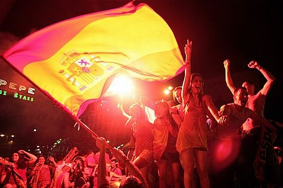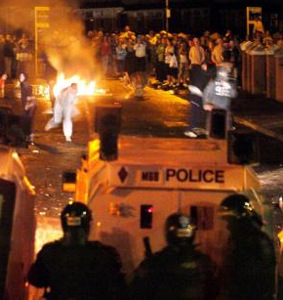Open Cities 23 Public Realm – Civic Behaviour
A lot has been written about how to design the public realm to contribute to city openness with more or less environmental determinism in mind. CABE’s work belongs to this knowledge base. It ranges from the very physical “Adapting Public Places to Climate Change” to “Open Spaces Strategies” with focus on green spaces for deprived areas, and “Inclusion by Design” which aims to produce places for everyone, removing barriers, helping to feel secure, acknowledging though that people experience the same place differently according to who they are. The latter describes group experiences by women, ethnic minorities, the mentally ill. (www.cabe.org.uk/)
Is it possible to design places where all these groups are comfortable and can mingle with each other? Or does the use of the public realm depend on other factors than its physical form and its maintenance?
Spain – Barcelona – Belfast
Three events which occurred in the same week come to mind to explore this question further, the Spaniards celebrating their football match wins, the Catalans claiming the right to their nationality and the violent clashes in Northern Ireland during the protestant marching season. All these events involved large crowds in the public realm.
In Barcelona one million and a half Catalans gathered during intense heat, displaying an enormous Catalan flag and refuting the findings of the court against their nationhood. All this took place in the public realm, the main thoroughfares and squares of the city centre without any serious incident. From toddlers to pensioners, the crowd was united in its cause and dispersed at sun set, hopeful that their communal action in the open city would yield results.
When the Spanish team won the semi final of the world football cup, Spaniards celebrated throughout Spain in the very hot public realm. The streets and squares around the stadia, Cibeles, the traditional square for manifestations in Madrid and public places everywhere in the city were full of people waving the Spanish flag, proud of their team. After they had won the World Cup, immense crowds celebrated in the streets and squares of Spanish cities, including Barcelona, despite its secessionist ambitions. Together they were proud of their team made up of players from all over Spain.
Compare this with Belfast, where recreational violence -as some called it – was invading the public realm, where children were agressing soldiers, adults fighting adults, mobs taking to the streets during the Orange Order parades. Clearly the two communities of the city are unable to share a common public realm, no matter how it is designed.
The Spanish events reflect that Spanish cities are open cities enabling all parts of civic society to belong. Many tourists had joined the festivities, in the case of the Barcelona demonstration often without even knowing the cause. It was an event which united all those sharing the public realm during a particular time. They were at ease, without fear, enjoying togetherness in the open city.
In the case of Belfast, riots raged days after days, people were hurt, factions expressed hatred against each other, in a fragmented city, a city with mental and sometimes physical boundaries, perpetuated, for one, through the segregated schooling system and the relentless reference to a particular vision of history, immutable, fixed and rigid, at one moment in the past, without any space for forgiveness or reconciliation.
Nature of Place – Nature or Nurture of Those Using It?
Most likely the physical spaces in all these cities have some intrinsic qualities. What distinguishes them is behaviour, the cultural make-up of those who use them. This is not to say that Spain is not capable of violence, just remember the civil war, nor should it mean that temperaments of the north are necessarily confrontational. For those who postulate open cities as a good condition for human cohabitation these events should provide food for thought. What is the solution for an open city? Is it a matter of shaping the environment, or reshaping human minds? And who would be in charge?





